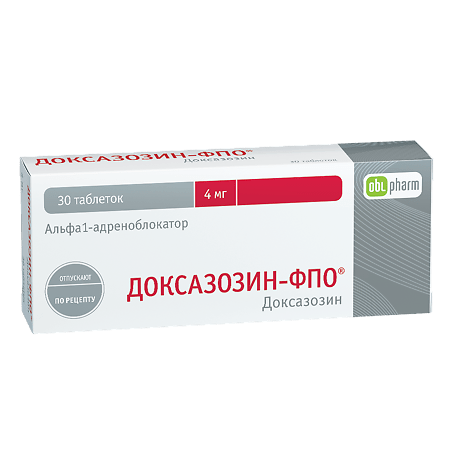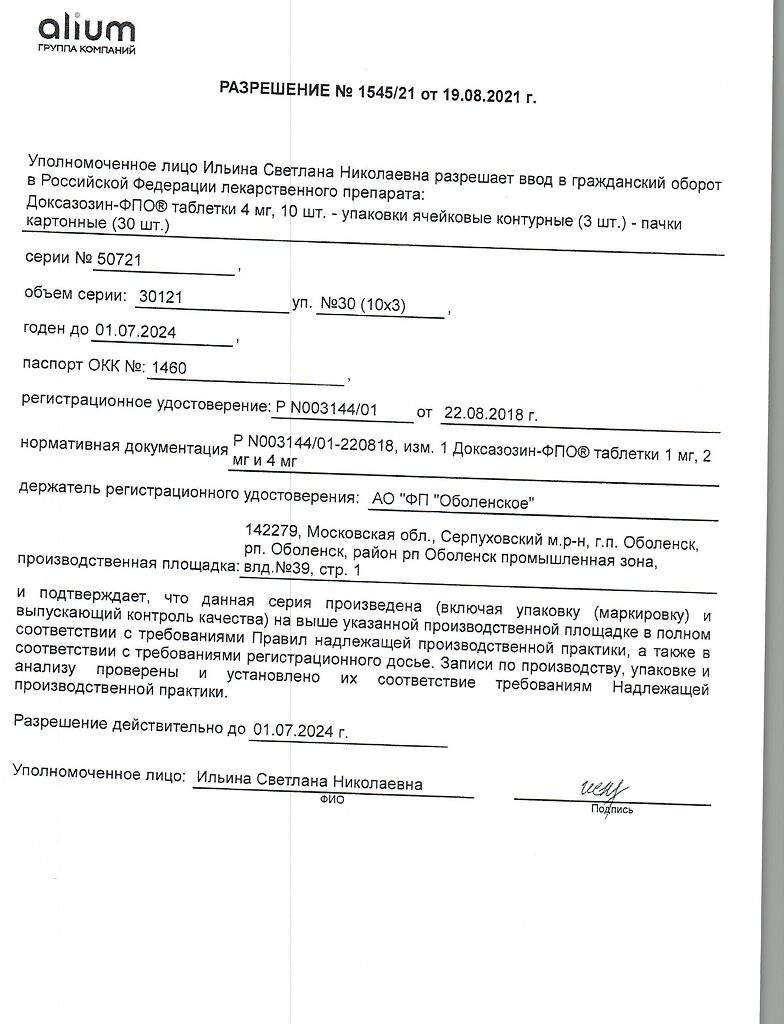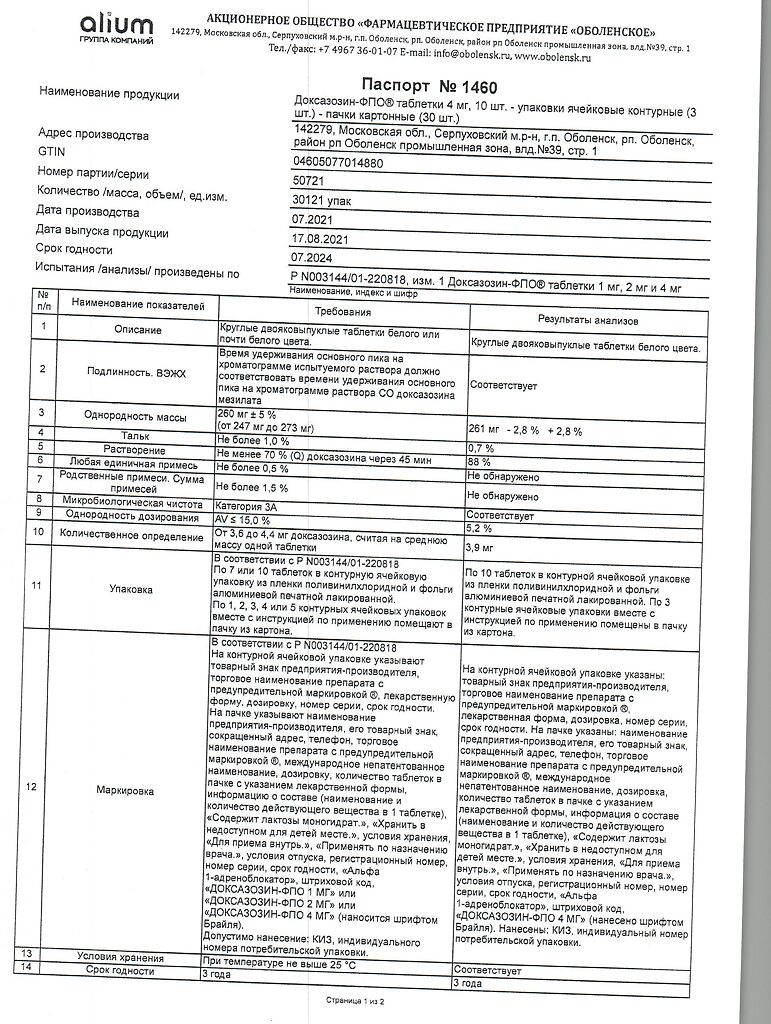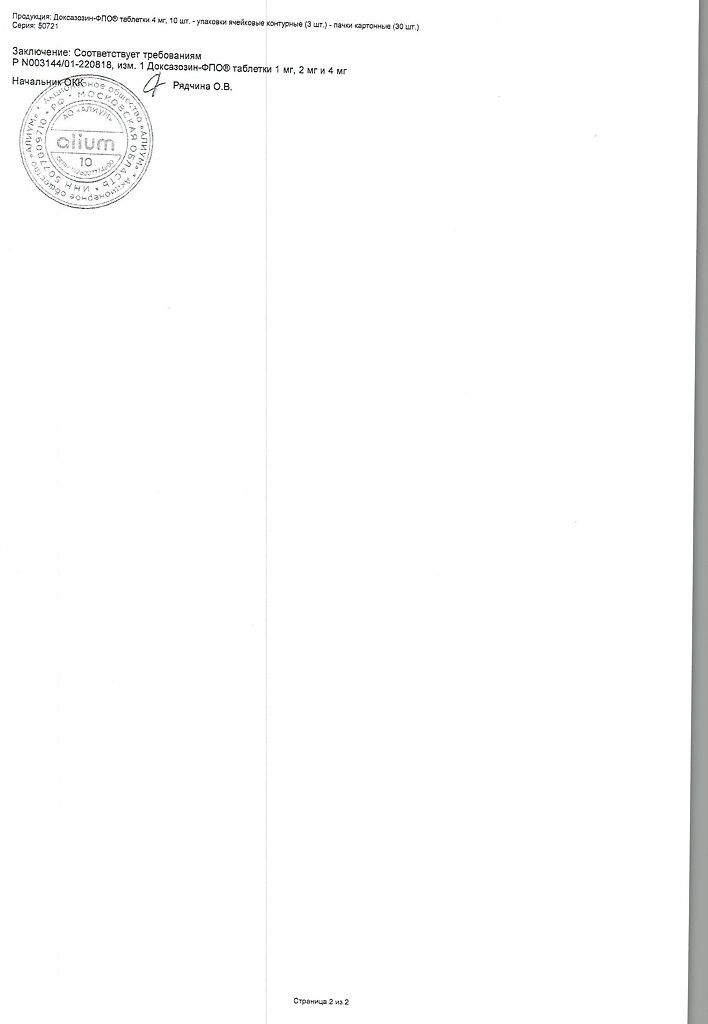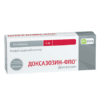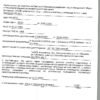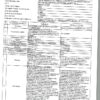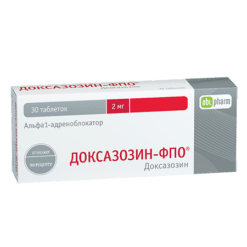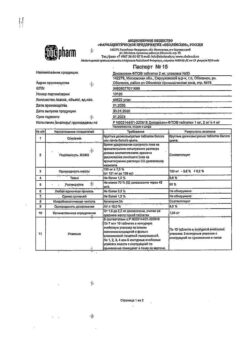No products in the cart.
Doxazosin-FPO, tablets 4 mg 30 pcs
€8.66 €7.49
Description
Pharmaceutical group:
alpha1-adrenoblocker
Pharmacodynamics:
Doxazosin is a selective competitive blocker of postsynaptic alpha1-adrenoreceptors (affinity for alpha1-adrenoreceptors is 600 times higher than for alpha2-adrenoreceptors), reduces total peripheral vascular resistance (PPR), prevents catecholamine-induced vasoconstriction, which ultimately leads to lower blood pressure (BP) without development of reflex tachycardia.
Limits the pre- and post-load on the heart. After a single dose, the decrease in BP develops gradually, the maximum decrease is observed in 2-6 hours and persists for 24 hours.
After a single dose of the drug, the maximum hypotensive effect is observed within 2 to 6 hours, and the overall hypotensive effect is maintained for 24 hours. During treatment with doxazosin in patients with arterial hypertension (AH) there is no difference in BP values in “standing” and “lying” position.
It is effective in AH, including when accompanied by metabolic disorders (obesity, decreased glucose tolerance).
Limits the risk of coronary heart disease (CHD). Administration of the drug in patients with normal BP is not accompanied by a decrease in BP. With long-term use of doxazosin, patients develop tolerance. </During doxazosin treatment, a decrease in plasma concentration of triglycerides and total cholesterol is observed. At the same time some increase (by 4-13%) of high density lipoprotein/total cholesterol ratio is observed.
Long-term treatment with doxazosin shows regression of left ventricular (LV) hypertrophy, suppression of platelet aggregation and increased content of active plasminogen in tissues.
Due to the fact that doxazosin blocks alpha1-adrenoreceptors located in the stroma and capsule of the prostate and in the bladder neck, there is a decrease of resistance and pressure in the urethra, reduction of internal sphincter resistance. Therefore administration of doxazosin to patients with symptoms of benign prostatic hyperplasia (BPH) results in significant improvement of urodynamic parameters and reduction of manifestation of the disease symptoms.
It has an effect in 66-71% of patients; the beginning of the effect is after 1-2 weeks of treatment and maximum effect is reached after 14 weeks; the effect remains long time.
Pharmacokinetics:
After oral administration at therapeutic doses, doxazosin is well absorbed, absorption is 80-90% (simultaneous food intake slows absorption by 1 hour), time to reach maximum plasma concentration (TCmax) is 3 hours, with TCmax prolonged to 5 hours with evening administration.
The bioavailability is 60-70%. Blood plasma protein binding is about 98%. Excretion from blood plasma occurs in 2 phases with final half-life (T½) – 19-22 hours, which allows to prescribe the drug once a day.
It is intensively metabolized in the liver by o-demethylation and hydroxylation. In patients with impaired hepatic function and when taking drugs which can change “hepatic” metabolism the process of biotransformation of the drug may be impaired. Main excretion is through intestine (63-65% as metabolites and about 5% – unchanged).
You can excrete about 10% by kidneys. Study of doxazosin pharmacokinetics in elderly patients and patients with kidney disease showed no significant pharmacokinetic differences.
Indications
Indications
Benign prostatic hyperplasia: both in the presence of arterial hypertension and in normal blood pressure levels.
Arterial hypertension (as part of combination therapy).
Pharmacological effect
Pharmacological effect
Pharmaceutical group:
alpha1-blocker
Pharmacodynamics:
Doxazosin is a selective competitive blocker of postsynaptic alpha1-adrenergic receptors (affinity for alpha1-adrenergic receptors is 600 times higher than for alpha2-adrenergic receptors), reduces total peripheral vascular resistance (TPVR), prevents vasoconstriction caused by catecholamines, which ultimately leads to a decrease in blood pressure (BP) without the development of reflex tachycardia.
Reduces pre- and afterload on the heart. After a single dose, the decrease in blood pressure develops gradually, the maximum decrease is observed after 2-6 hours and persists for 24 hours.
After a single dose of the drug, the maximum hypotensive effect is observed in the period from 2 to 6 hours, and in general the hypotensive effect persists for 24 hours. During treatment with doxazosin in patients with arterial hypertension (AH), there are no differences in blood pressure values in the “standing” and “lying” positions.
Effective for hypertension, including those accompanied by metabolic disorders (obesity, decreased glucose tolerance).
Reduces the risk of developing coronary heart disease (CHD). Taking the drug in patients with normal blood pressure is not accompanied by a decrease in blood pressure. With long-term use of doxazosin, patients develop tolerance.
During treatment with doxazosin, a decrease in the concentration of triglycerides and total cholesterol in the blood plasma is observed. At the same time, there is a slight (4-13%) increase in the high-density lipoprotein/total cholesterol ratio.
With long-term treatment with doxazosin, regression of left ventricular (LV) hypertrophy, suppression of platelet aggregation and an increase in the content of active plasminogen in tissues are observed.
Due to the fact that doxazosin blocks alpha1-adrenergic receptors located in the stroma and capsule of the prostate gland and in the neck of the bladder, there is a decrease in resistance and pressure in the urethra, and a decrease in the resistance of the internal sphincter. Therefore, the administration of doxazosin to patients with symptoms of benign prostatic hyperplasia (BPH) leads to a significant improvement in urodynamic parameters and a decrease in the manifestations of symptoms of the disease.
It has an effect in 66-71% of patients, the onset of action is after 1-2 weeks of treatment, maximum after 14 weeks, the effect lasts for a long time.
Pharmacokinetics:
After oral administration in therapeutic doses, doxazosin is well absorbed, absorption is 80-90% (simultaneous food intake slows down absorption by 1 hour), the time to reach the maximum concentration in the blood plasma (TCmax) is 3 hours, and when taken in the evening, TCmax is extended to 5 hours.
Bioavailability – 60-70%. Communication with blood plasma proteins is about 98%. Elimination from blood plasma occurs in 2 phases, with a final half-life (T½) of 19-22 hours, which allows the drug to be administered once a day.
Intensively metabolized in the liver by o-demethylation and hydroxylation. In patients with impaired liver function, as well as when taking drugs that can alter hepatic metabolism, the biotransformation process of the drug may be disrupted. The main excretion is through the intestines (63-65% in the form of metabolites and about 5% unchanged).
About 10% is excreted by the kidneys. A study of the pharmacokinetics of doxazosin in elderly patients and patients with kidney disease did not reveal significant pharmacokinetic differences.
Special instructions
Special instructions
Particular caution should be exercised when using the drug Doxazosin in patients with impaired liver function, especially in cases where drugs that can alter hepatic metabolism (for example, ethanol, barbiturates, phenylbutazone, tricyclic antidepressants, cimetidine) are simultaneously used. In cases of deterioration of the functional state of the liver, the drug is immediately discontinued.
In order to prevent orthostatic reactions, patients should avoid unexpected and sudden changes in body position (moving from the “lying” to the “standing” position).
Caution should be exercised when taking phosphodiesterase-5 inhibitors and doxazosin simultaneously, because Arterial hypotension may develop. To reduce the risk of developing arterial hypotension (including orthostatic), it is necessary to begin treatment with phosphodiesterase-5 inhibitors only if the patient has adapted to doxazosin therapy; in addition, a 6-hour interval from doxazosin should be observed between doses of drugs.
During surgical interventions for cataracts while taking the drug, the development of intraoperative instability syndrome of the iris (narrow pupil syndrome) is possible, which must be taken into account by the surgeon for preoperative preparation of the patient and during the operation.
Alcohol intake can increase the adverse reactions of doxazosin.
The effect of the “first dose” of the drug is especially pronounced against the background of previous diuretic therapy and a sodium-restricted diet.
Before starting therapy, it is necessary to exclude prostate cancer.
Impact on the ability to drive vehicles and other mechanisms
If you are taking Doxazosin, you should be careful when driving vehicles or performing work that requires increased concentration and speed of psychomotor reactions.
Active ingredient
Active ingredient
Doxazosin
Composition
Composition
1 tablet contains:
active ingredient:
doxazosin mesylate 1.22 mg/2.44 mg/4.88 mg (in terms of doxazosin
1 mg/2 mg/4 mg);
excipients:
lactose monohydrate 80.18 mg/
90.16 mg/180.32 mg;
calcium phosphate 17.0 mg/35.0 mg/70.0 mg;
povidone K30 0.4 mg/0.6 mg/1.2 mg;
sodium lauryl sulfate 0.2 mg/0.3 mg/0.6 mg;
calcium stearate 0.5 mg/1.0 mg/2.0 mg;
talc
0.5 mg/0.5 mg/1.0 mg
Contraindications
Contraindications
Hypersensitivity to doxazosin and other quinazoline derivatives (prazosin, terazosin) or to other components of the drug;
Tendency to orthostatic hypotension;
Hypertension (for patients with benign prostatic hyperplasia);
Patients with BPH and concomitant obstruction of urine outflow from the upper urinary tract, chronic urinary tract infections, bladder stones;
Lactose intolerance, lactase deficiency or glucose-galactose malabsorption;
Lactation period;
Age up to 18 years (efficacy and safety have not been established);
As monotherapy in patients with either a full bladder or anuria with or without progressive renal failure.
With caution: Pulmonary edema due to aortic or mitral stenosis;
Right-sided heart failure due to pulmonary embolism or exudative pericarditispravostoronnyaya serdechnaya nedostatochnostʹ vsledstvie legochnoĭ embolii or ekssudativnyĭ perikardit;
Left ventricular heart failure with low filling pressure;
Concomitant use of phosphodiesterase-5 inhibitors (sildenafil, vardenafil, trandalafil);
Syndrome of intraoperative instability of the iris (small pupil syndrome);
Liver dysfunction.
Side Effects
Side Effects
The frequency of adverse reactions when using the drug Doxazosin is given below in accordance with the generally accepted classification:
very often (≥1/10); often (≥1/100, <1/10); uncommon (≥1/1000, <1/100); rare (≥1/10000, <1/1000); very rare (<1/10000).
From the cardiovascular system: often – hypertension (including orthostatic), palpitations, tachycardia; infrequently – angina pectoris, myocardial infarction; very rarely – bradycardia, rhythm disturbances, “flushes” of blood to the facial skin, peripheral edema.
From the central and peripheral nervous system: often – drowsiness, dizziness, headache; uncommon – stroke, hypoesthesia, fainting, tremor, agitation, depression, anxiety, insomnia, nervousness; very rarely – paresthesia, postural dizziness.
From the senses: often – vertigo; infrequently – ringing in the ears; very rarely – blurred vision, narrow pupil syndrome.
From the digestive system: often – abdominal pain, dyspepsia, dryness of the oral mucosa; uncommon – constipation, bloating, vomiting, diarrhea, increased activity of liver enzymes, loss of appetite, anorexia; very rarely – hepatitis, cholestasis, jaundice.
From the respiratory system: often – bronchitis, cough, shortness of breath, rhinitis, dry nasal mucosa; uncommon – nosebleeds; very rarely bronchospasm.
From the hematopoietic organs: leukopenia, thrombocytopenia.
From the musculoskeletal system: often – back pain, myalgia; not often – arthralgia; rarely – cramps, muscle weakness.
From the skin: often – itching; uncommon – skin rash; very rarely urticaria, alopecia, purpura.
From the genitourinary system: often cystitis, urinary incontinence; not often – dysuria, increased frequency of urination, hematuria, impotence, gout; rarely – polyuria; very rarely – increased diuresis, urination disorder, nocturia, gynecomastia, priapism, retrograde ejaculation.
General reactions: often – asthenia, chest pain, malaise; uncommon – pain, swelling of the face, weight loss; very rarely – allergic reactions, fatigue.
Interaction
Interaction
Doxazosin enhances the antihypertensive effect of antihypertensive drugs (when used in combination with them, dose adjustment is required).
No adverse interactions were observed with the simultaneous use of doxazosin and thiazide diuretics, furosemide, beta-blockers, slow calcium channel blockers, angiotensin-converting enzyme inhibitors, antibacterial agents, hypoglycemic agents for oral administration, indirect anticoagulants and uricosuric agents.
The drug does not affect the degree of binding of digoxin and phenytoin to plasma proteins.
When used simultaneously with inducers of microsomal oxidation enzymes in the liver (ethanol, barbiturates, phenylbutazone, tricyclic antidepressants), the effectiveness of doxazosin may increase, and with inhibitors (cimetidine) – a decrease.
Nonsteroidal anti-inflammatory drugs (NSAIDs), especially indomethacin, estrogens (fluid retention) and sympathomimetic agents may reduce the hypotensive effects of doxazosin.
By eliminating the alpha-adrenergic stimulating effects of epinephrine, it can lead to tachycardia and arterial hypotension.
Concomitant use with selective phosphodiesterase-5 inhibitors (sildenafil, tadalafil, vardenafil) can lead to the development of arterial hypotension.
Overdose
Overdose
Symptoms: pronounced decrease in blood pressure, sometimes accompanied by fainting.
Treatment: gastric lavage, taking activated carbon.
The patient must be placed on his back and his legs elevated. If there is a pronounced decrease in blood pressure, anti-shock measures are carried out – the volume of circulating blood is replenished, and vasopressors are prescribed if necessary.
Hemodialysis is ineffective.
Storage conditions
Storage conditions
In a place protected from light, at a temperature of 5–25 °C.
Shelf life
Shelf life
2 years.
Manufacturer
Manufacturer
Obolenskoye FP JSC, Russia
Additional information
| Shelf life | 2 years. |
|---|---|
| Conditions of storage | In a light-protected place at 5-25 °C. |
| Manufacturer | Obolenskoe FP JSC, Russia |
| Medication form | pills |
| Brand | Obolenskoe FP JSC |
Other forms…
Related products
Buy Doxazosin-FPO, tablets 4 mg 30 pcs with delivery to USA, UK, Europe and over 120 other countries.

